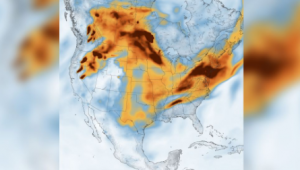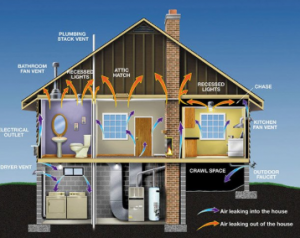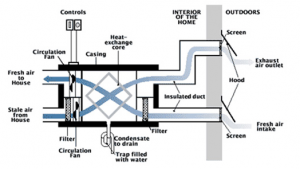written by MEC’s Buildings Department program manager, Mary English
Since the days that our ancient ancestors started erecting structures to get out of their damp, dark caves, buildings have been our haven from the elements. As our technology has improved from sod, thatched roofs, and log structures, our faith in our buildings has grown into one of the bedrocks of civilizations around the globe.
In the modern era, new construction has the latest and greatest innovations available to society to protect us from Mother Nature’s fiercest tendencies. And as technologies have improved, the general belief might be that building codes – our rules and regulations that protect consumer interests – have upgraded right along with them to create ever more reliable shelters.
Unfortunately, that assumption does not necessarily reflect reality. Plus, improving codes does not address the problem of existing buildings that are years, decades or even centuries out of date. This has never been more demonstrable than this year when record breaking temperatures and wildfires have resulted in poor air quality across the United States.
The effect of outdoor air quality on indoor air
Outdoor air quality has been particularly dangerous this year. This is true especially in the West where wildfires are raging. Our structures are not equipped with the technology they need to provide a safe breathing environment inside when these outdoor conditions exist.
This snip (taken from the New York Times) perfectly sums it up this way:
Even air quality experts are still trying to wrap their heads around this crisis. Sarah Coefield, who heads up Missoula’s smoke readiness program for the local health department, said that when the valley was socked in with dangerous levels of smoke in 2017, the county was completely unprepared.
“These extreme smoke events are a few decades old but the frequency we’re seeing is still quite new,” she said. “In 2017, I didn’t know half of what I know now about indoor ventilation systems. Many of us still assumed most indoor buildings had clean air during fires.”
Ms. Coefield’s research since 2017 has shown that the air quality in many of the town’s public buildings during extreme smoke events is nearly as dangerous as the air outside. Her team found that many HVAC systems were outdated, missing filters or broken altogether.
“We want to tell people to go inside for clean air — to the mall or the office or the movie theater,” she said. “We don’t even know if the air they’re breathing there is clean.”
It’s easy to dismiss this as a localized temporary problem out in low-populated areas, but as our planet is a sealed eco-system this is a problem that is impacting all of us at some level. In fact, as I type this sentence, this is the weather note displayed in the lower right-hand corner of my screen:

Not “cloudy” or “sunny.” “Polluted air” is now the unprecedented message for the Kansas City metro as seen on my computer screen. My local weather service station has explained it has everything to do with the Western blazes. In fact, space satellite data made news in July by sharing images of wildfire smoke blanketing most of North America.

Black carbon particulates from wildfires spreads eastward across the U.S. in this image captured July 21, 2021.
(Image credit: Joshua Stevens/NASA Earth Observatory)
And as the American Lung Association (ALA) documents annually, the issue of poor outdoor air quality is not isolated to fire season. The presence of ozone in our breathed air is a big problem across the United States in multiple cities and counties. The ALA relates the toll this takes on citizens’ health as increasing the risk of premature death, as well as increased risk of heart and respiratory disease.
This problem and its costs are extremely widespread. To date, no one has found a way to quantify the toll that poor outdoor air quality lays on our healthcare system and economy in general. Add to this indoor air quality that is negatively impacted by internal particulates that can lead to sick building syndrome, which is another – albeit related – topic.
Balanced ventilation as a ready solution
Quantifying the impact of poor to toxic outdoor air quality on our health is too large to measure easily. But luckily, we don’t need to wait years for the results of an expensive study to start implementing solutions. We already know what will protect American citizens from outdoor air pollutants: much more efficient buildings that are built (or renovated) tight and ventilated right.
Most of our building stock – especially houses – are not considered “tight.” This means outside air can infiltrate every second from gaps in the lower part of the house into houses on cold, windy days (as just one example); and conditioned air can escape through the top of the home through leaky lighting fixtures, windows, and attic hatches. This image demonstrates how the air moves into and out of our buildings:

We must tackle the problem of inefficient leaky buildings and correct ventilation practices together. If the house is already as porous as a sieve there is no point in adding an air filtration system, since you’ll still get plenty of toxic air coming in through your house’s cracks and gaps. (Especially when the clothes dryer is running, which is exhausting 250 cubic feet per minute (CFM). In other words, that is 250 CFM of outside air that will be “leaking” back into your house to make up the difference).
First, let’s talk a bit about how mechanical ventilation works. In concept, it’s like thinking about how societies create potable water: it is all about the filtration system. Simply, a balanced mechanical ventilation system relies on filters to catch pollutants as outdoor air is pulled into the building. As outside air is drawn inside, it passes through both a filter and a heat exchanger to temper the air on extreme temperature days while stale air is vented out at the same rate.
The word “balanced” is important when discussing the need to filter outdoor air pollutants. Currently mechanical ventilation isn’t required by residential codes to be balanced. This is because, as our buildings have been getting tighter due to better materials and practices, the thought was that as long as the air inside the house was being exchanged for fresh air from the outdoors, we were protecting the residents from sick building syndrome as people are subject to other problems that can arise in tight buildings, such as mold or carbon monoxide.
Currently, most residential code allows for ventilation systems to be exhaust only (think bathroom exhaust for example); intake only (a simple fresh air intake); or balanced, which manages both to keep the pressure in the house neutral.

Heat Recovery Ventilator Website. 28 Jan 2005. Canada. Office of Energy Efficiency. www.oee.nrcan.gc.ca/Publications/infosource/Pub/hrv/hrvsystem.cfm?text=N&printview=N.
As one can see by the date on the image, this technology has existed for some time now. Since balanced ventilation is not required by most code, however, it is not widely used enough to be familiar or relatively inexpensive compared to other, cheaper systems. Except now our outdoor environment is becoming more hostile for human habitation, and we must make balanced ventilation the building industry’s default.
Introducing the IECC 2021, the best available building standards
As awareness grows over indoor air quality and efficient building practices, we have a roadmap already in hand for new buildings: the International Energy Conservation Code (IECC) 2021 codes, published at the end of 2020. These codes are a considerable improvement over the 2018 code publication. The International Codes Council estimates that IECC 2021 represents a 9.5% energy improvement over the 2018 codes.
Whole-building energy retrofits and renovations could be seen as a little trickier than achieving energy efficiency in new buildings. Our existing building stock isn’t uniform, since tastes and technologies have evolved over the decades. Plus, whenever you are talking about constructing buildings anywhere it is imperative that the micro-climate and zone is incorporated into design considerations. (For example, a building in Toronto must be designed to withstand harsh winters, where a structure in Orlando, FL needs to be constructed for a long cooling season instead).
However, cities, developers and contractors have a wide array of resources that can help navigate what needs to be done. For example, the U.S. Department of Energy has a series of robust publications called the Advanced Energy Retrofit Guides offering guidance on renovations based on building types and industry. The guides are readily available and free online to download.
In general, when you look at the best practices when renovating an existing building or constructing from the ground up, this is what jurisdictions need to gravitate towards if we are going to realistically maintain true shelters from poor air quality and other elements:
- A building envelope (foundation, walls, and roofs) that are well insulated and airtight. (This means proper installation of efficient windows and doors is a must as well.)
- An HVAC system that is properly designed, tested, and installed to fit the needs of the occupants. If the building contains a ducted forced air system, it is critical that the ductwork is also airtight.
- A ventilation system that delivers fresh air to a tight building. This would be ventilation that is properly designed based on the number of occupants in the building; is tested; and is maintained well, once completed with regular commissioning conducted to ensure top performance and system efficacy.
- For commercial buildings, a smart, fully automated building operating system is prudent as well. Software that is truly ‘smart’ is programmed to detect any early problem that may hint at potential malfunctions, so as to catch and fix the problem early on in the HVAC equipment’s life cycle.
Many new commercial contractors are already following this methodology but depending on the jurisdiction and laws governing code implementation, we could still do a lot better to ensure that both our residential and commercial spaces meet the criteria set by building codes.
It is imperative that governments at all levels take best practices in building science seriously. If we have nowhere to go—not even inside our homes and other shelters—when our air quality is poor, then our suffering through the increasingly dire climate emergencies of fires, floods and persistently bad ozone will only increase. And the costs will be absolutely immeasurable.
Now is the time to act
We have the technology to confront poor air quality. Now we just need the will to act. Imagine a world where we have healthy buildings with purified air where together we can safely tackle the climate emergency already at our doorstep. There is still time to preserve a future for the younger generations, but we need to act now. And we need clean air to sharpen our focus on implementing the best solutions.
